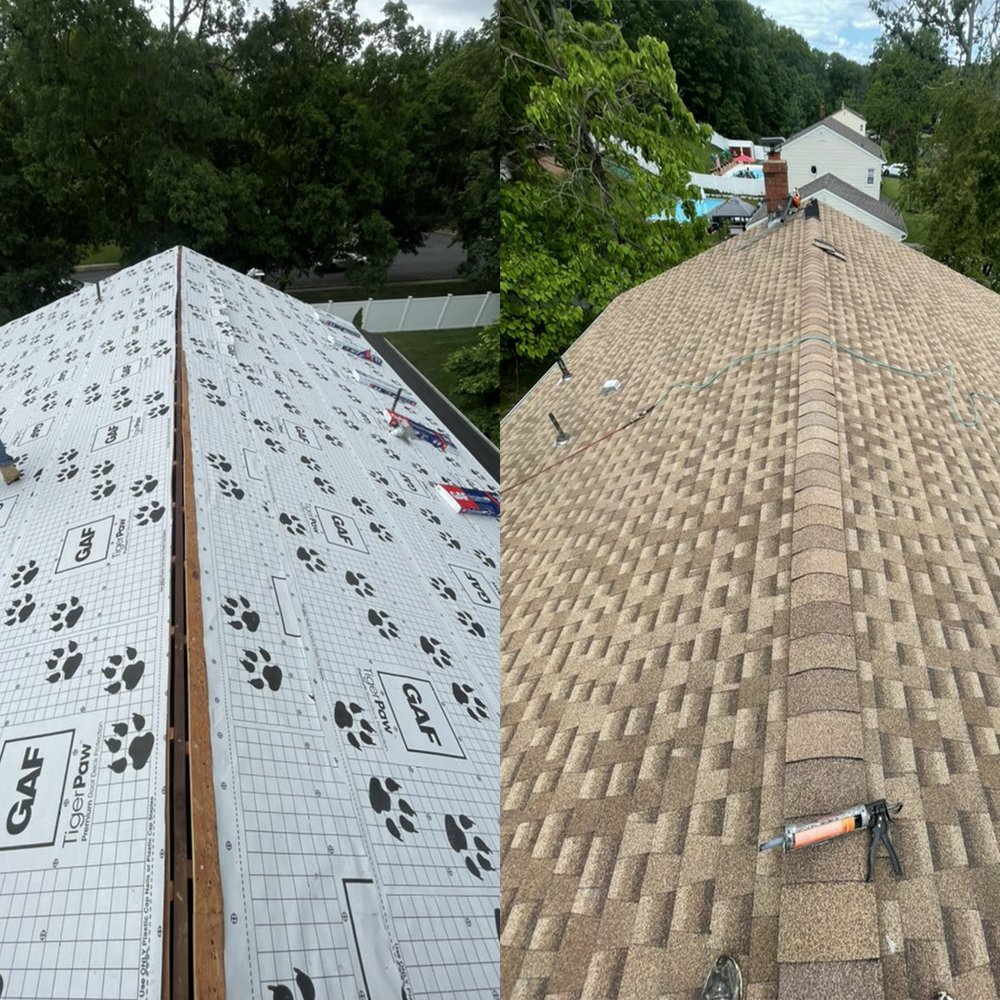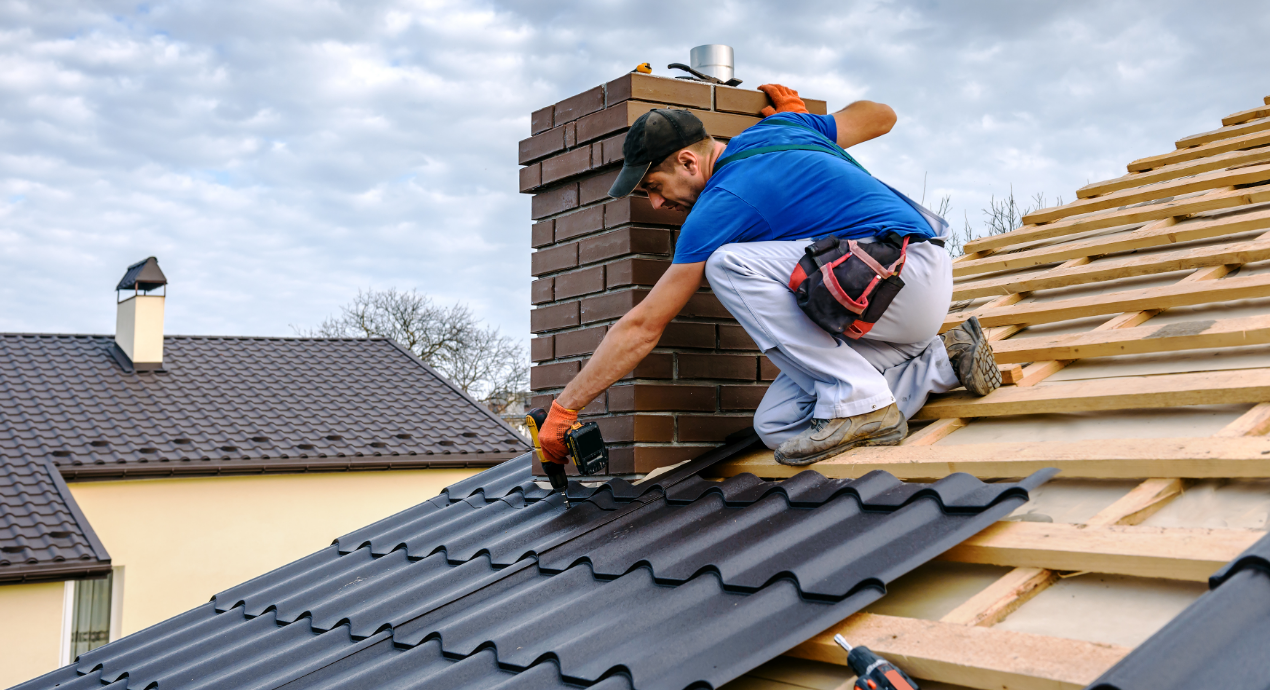Exploring the Numerous Kinds of Roofs: Which One Is Ideal for Your Home?
When thinking about the myriad kinds of roofs available, it is vital to assess just how each choice aligns with your home's unique demands, consisting of climate problems, aesthetic choices, and structural performance. From the traditional gable roof that efficiently channels rain to the modern-day level roofing system offering metropolitan versatility, each design presents distinct advantages and difficulties.
Saddleback Roof
Saddleback roofs, characterized by their triangular shape and sloping sides, are a preferred selection amongst property owners seeking both aesthetic charm and performance. This roof covering style efficiently permits effective water runoff, lowering the risk of water merging and succeeding damages. In addition, the steep slopes develop adequate attic room room, which can be utilized for storage or perhaps converted right into living locations.
Among the primary advantages of saddleback roofs is their ability to hold up against rough weather. The design aids in lessening wind resistance, making them especially ideal for areas vulnerable to storms. Additionally, gable roofs can be constructed utilizing a variety of products, consisting of tiles, ceramic tiles, and steel, giving home owners with versatility in style and budget.
From an architectural perspective, saddleback roofs can boost the visual appeal of a home, using a classic and classic appearance. They can complement different building designs, from traditional to contemporary designs. Nonetheless, it is important to take into consideration prospective downsides, such as the sensitivity to snow buildup in cooler climates. Generally, saddleback roofs continue to be a favored choice as a result of their balance of usefulness and design, appealing to a wide array of property owners.
Apartment Roofs
While often neglected for more conventional roofing styles, level roof coverings supply one-of-a-kind benefits that accommodate particular architectural requirements and modern layout preferences. These roofing systems are characterized by their minimal pitch, permitting reliable usage of area, especially in city environments where maximizing square video is crucial.
One considerable benefit of flat roofs is their versatility. They can be utilized as extra home, such as rooftop gardens, outdoor patios, or solar panel installations, boosting the capability of a home. Furthermore, level roofings are usually much easier and more secure to navigate throughout upkeep, helping with repairs and examinations without the difficulties posed by steep slopes.
Level roofings can also be a lot more cost-efficient in terms of products and installation. With a less complex style, they frequently call for fewer sources, converting into reduced labor prices. Nevertheless, it's important to consider drain and waterproofing, as level roofings can be susceptible to merging water if not appropriately made.

Hip Roof Coverings
Hip roof coverings attract attention for their sophisticated design and structural integrity, making them a preferred selection among homeowners. Characterized by inclines on all 4 sides, hip roof coverings provide a well-balanced aesthetic that matches different architectural designs - roof repair oahu. The symmetrical nature of these roofs aids to disperse weight evenly, improving stability more tips here and resilience
Among the crucial advantages of hip roofing systems is their ability to hold up against extreme weather. The sloped surfaces facilitate reliable water drainage and snow drainage, decreasing the threat of leaks and architectural damage. In addition, the layout minimizes wind resistance, making hip roofings less at risk to wind uplift contrasted to other roofing types.


Shed Roofings
Dropped roof coverings, as opposed to the intricacy of hip roof coverings, offer a structured and minimal style that interest modern aesthetics. Identified by a single sloping surface, dropped roofings are typically utilized in modern architecture, garden sheds, and various other functional structures. This simpleness not only improves visual charm but additionally permits effective water runoff, making them appropriate for numerous environments.
Among the key benefits of shed roofs is their cost-effectiveness. With less products called for and a straightforward installment process, homeowners can conserve both time and money. The style also permits the consolidation of big windows or skylights, promoting natural light and developing sizable interiors.
Nevertheless, it is necessary to think about the potential drawbacks, including minimal insulation alternatives and the need for cautious style to prevent extreme heat buildup. Furthermore, shed roofs might not mix effortlessly with standard architecture, which might be a concern for some homeowners.
Ultimately, lost roofings offer a stylish and sensible roof service for those seeking modernity and effectiveness. When selecting a roof type, evaluating personal functional demands and aesthetic choices will guide home owners to the most effective choice for their one-of-a-kind requirements.
Mansard Roofs
Mansard roofings, characterized by their unique four-sided design, are a characteristic of French design that incorporates beauty with capability. This building design features 2 inclines on each side, with the lower incline being steeper than the upper one. The unique configuration permits additional space in the upper degrees, making it an excellent option for home owners seeking to maximize functional location without expanding the structure's impact.
One of the considerable benefits of a mansard roof is its convenience. It can be adapted to numerous building styles, from conventional to modern-day, improving the visual appeal of any home. Furthermore, the adequate room created under the roof can easily fit dormer windows, which enable for all-natural light and ventilation, more enhancing the comfort of the living area.
Nevertheless, possible homeowners need to take into consideration the maintenance requirements associated with mansard roofs. The high slopes can result in enhanced wear from weather condition exposure, requiring regular maintenances. In addition, installment prices might be higher compared to easier roofing styles because of the complexity of construction. Ultimately, a mansard roofing can be an exceptional visit this web-site option for those prioritizing design and room.
Verdict
Each roof covering style provides special benefits, such as the performance of gable roofs, the modern-day charm company website of shed roofings, and the security of hip roof coverings. Level roofs supply functionality for metropolitan settings, while mansard roof coverings give additional living space regardless of higher installation costs.
From the classic gable roofing system that effectively networks rain to the modern flat roof offering urban adaptability, each design presents distinctive benefits and difficulties (roof repair oahu). Furthermore, the style reduces wind resistance, making hip roofing systems much less prone to wind uplift contrasted to other roof kinds
Lost roofings, in comparison to the intricacy of hip roofing systems, provide a streamlined and minimal layout that allures to contemporary aesthetic appeals. Each roof design presents special advantages, such as the performance of gable roofings, the modern allure of shed roofings, and the security of hip roof coverings. Flat roofing systems supply functionality for urban settings, while mansard roofs provide extra living space regardless of higher installment costs.